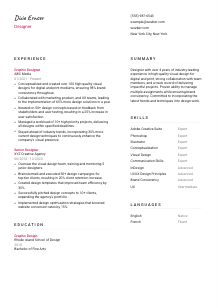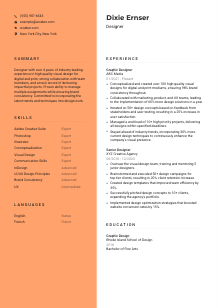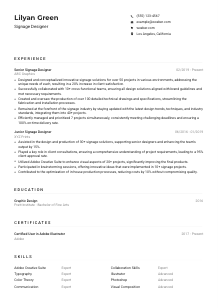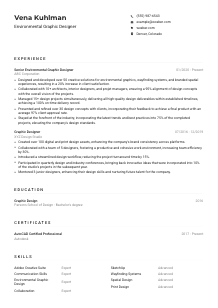Designer Resume Example
Sketching visions, but your resume feels like a rough draft? Delve into this Designer resume example, refined with Wozber free resume builder. Discover how to bring your creative flair to align with job specifications, crafting a career canvas that's always on-trend and in high demand!

How to write a Designer Resume?
Welcome, aspiring Design maestro! The realm of design is vibrant and evolving, making competition fierce. Your resume, therefore, is not merely a document; it's your personal gallery, showcasing your conceptual prowess and aesthetic sensibility. With the guidance of the Wozber free resume builder, this blueprint will lead you through tailoring a resume finely tuned to the unique cadence of a Designer role, ensuring it's both ATS-compliant and reflective of your individual flair.
Ready to weave your visual narrative? Let's paint your career journey with broad strokes of excellence and precision!
Personal Details
The Personal Details section is the initial handshake with your potential employer, setting the tone for the dialogue that your resume will continue. Let's explore how to fine-tune this section for a Designer position, making it a perfect match for the job requirements.
1. Make Your Name Your Brand
Your name is the marquee of your personal brand, so let it shine. Opt for a clean, bold typography that's a notch above the rest of the resume in size. This visual hierarchy not only makes your name memorable but also demonstrates your knack for thoughtful design.
2. Tailor Your Title
Directly below your name, mirror the job title from the description. This ‘Designer' label acts as a keyword for Applicant Tracking Systems (ATS) and instantly aligns your application with the role, subtly asserting your suitability and intent.
3. Essential Contact Information
Accuracy and professionalism are key. Provide an accessible phone number and a professional email address, preferably your firstname.lastname@email.com. This format speaks to your attention to detail—a critical attribute for any Designer.
4. Address for Success
The requirement for being located in "New York City, New York" is specific and non-negotiable. By stating this in your contact details, you immediately satisfy a crucial criterion, assuring potential employers of your availability and readiness.
5. Web Presence
For a Designer, your portfolio is paramount. Include a link to your personal website or a professional profile like LinkedIn where your work can shine. Ensure it's current and reflects the breadth and depth of your design philosophy and achievements.
Takeaway
Think of the Personal Details section as a brief but impactful introduction. It's your opportunity to ensure every detail—down to the choice of font and layout—reflects your expertise as a Designer. Make every element count, setting the stage for a compelling narrative about your professional journey.





Experience
Now, let's dive deep into illustrating your experience. This is your arena to showcase past projects and roles where you've brought concepts to life. Aligning your experiences with the role's requirements demonstrates not just your qualification, but your capacity to excel as a Designer.
- Conceptualized and created over 100 high‑quality visual designs for digital and print mediums, ensuring 98% brand consistency throughout.
- Collaborated with marketing, product, and UX teams, leading to the implementation of 60% more design solutions in a year.
- Iterated on 50+ design concepts based on feedback from stakeholders and user testing, resulting in a 25% increase in user satisfaction.
- Managed a workload of 10+ high‑priority projects, delivering all designs within specified deadlines.
- Stayed ahead of industry trends, incorporating 30% more current design techniques to continuously enhance the company's visual presence.
- Oversaw the visual design team, training and mentoring 5 junior designers.
- Brainstormed and executed 50+ design campaigns for top‑tier clients, resulting in 20% client retention increase.
- Created design templates that improved team efficiency by 35%.
- Successfully pitched design concepts to 10+ clients, expanding the agency's portfolio.
- Implemented design optimization strategies that boosted website conversion rates by 15%.
1. Dissect the Role
Start by dissecting each line of the job description. Seek to understand the specific skills and types of projects the employer values. This deep dive will guide you in highlighting your most relevant and impressive design achievements.
2. A Showcase of Roles
Present your experience in reverse chronological order, leading with your recent role. For each position, include your job title, company name, and tenure. This structure not only aids ATS optimization but also makes your career trajectory easy to follow.
3. Accomplishments with Impact
Detail achievements that resonate with the Designer role. For example, "Collaborated with marketing, product, and UX teams" directly mirrors a key responsibility. This tailored approach makes your application compelling and relevant.
4. Numbers Tell Stories
Whenever possible, quantify your achievements. Did your design increase user satisfaction by 25% or improve brand consistency by 98%? These figures offer tangible proof of your impact, grabbing attention and conveying your value unequivocally.
5. Relevance Reigns
Keep the focus on experiences that directly relate to the job requirements. Unrelated accolades, while impressive, can distract from the narrative you're crafting. Each bullet point should confirm why you're the ideal candidate for this Designer role.
Takeaway
Consider the Experience section as your professional expo, a space where your design projects and collaborations take center stage. Tailor each entry to reflect the job description, making it abundantly clear that you're not just a fit—you're a formidable contender.
Education
The Education section might seem like a straightforward recount of your academic credentials, but for a Designer, it's an opportunity to underscore your foundational knowledge in design principles. Here's how to sculpt this section to reflect your readiness for the role.
1. Identify Educational Prerequisites
The job specifies a "Bachelor's degree in Graphic Design, Visual Communication, or a related field". Echo this requirement if your degree aligns, instantly establishing your educational compatibility with the role's demands.
2. Simplicity and Clarity
Maintain clarity with a straightforward structure: Degree, Field, University, and Graduation Year. This clean layout respects the hiring manager's time and keeps their focus on your qualifications.
3. Degree Specificity
If the job asks for a particular field of study and you have it, highlight it. For the Designer example, "Bachelor of Fine Arts in Graphic Design" perfectly matches the job criteria, leaving no room for doubt about your educational alignment.
4. Coursework and Projects
If you're early in your career, relevant coursework or projects can supplement your degree, hinting at your potential. For seasoned professionals, the degree itself will suffice, as your experience carries more weight.
5. Additional Achievements
Graduating with honors or participating in design-centric organizations or projects can earn you extra points, especially for entry-level roles. For senior positions, prioritize experience and skill proficiency.
Takeaway
Your Education section solidifies your technical foundation in design. Tailor it to reflect the job requirements, ensuring it reinforces your capability and preparedness for the role. Let your academic credentials stand as a testament to your commitment to design excellence.
Skills
The Skills section of your resume is like a curated gallery of your professional capabilities. For a Designer, this is where you highlight both your creative prowess and your technical expertise. Let's finesize how to make this section impactful, aligned explicitly with the job requirements.
1. Extract from the Job Description
First, comb through the job description, noting both stated and inferred skills. This thorough approach ensures you're speaking the employer's language, mirroring their needs with your capabilities.
2. Match and List
Directly match your skills with those listed in the job requirements. For designers, this includes proficiency in Adobe Creative Suite, conceptualization, and UI/UX design principles. Nest these keywords throughout your skills section for ATS optimization.
3. Prioritize and Organize
Instead of listing every skill, prioritize those directly relevant to the role. Arrange them in a way that first highlights your strengths in design software and principles, followed by soft skills like communication and collaboration, essential for cross-functional teamwork.
Takeaway
Your Skills section is your chance to confidently declare your capacity to excel in the Designer role. By strategically selecting and organizing your skills, you assure prospective employers of your proficiency and potential. Each listed skill is a brushstroke in the masterpiece that is your career.
Languages
In the global ecosystem of design, language proficiency can serve as a bridge to clients and teams across borders. Here's how to creatively integrate your language skills into your resume, turning them into an asset for international collaborations and opportunities.
1. Job Requirements Audit
The job outlined "Proficient English language skills required". If English is your native or second language, list it first to align with this essential requirement, affirming your ability to communicate effectively in the role's primary language.
2. Showcase Language Diversity
After listing English, add any additional languages you speak. This not only demonstrates your versatility but also signals your capability to engage in diverse cultural contexts, a valuable asset in creative domains.
3. Clarity in Proficiency
Be explicit about your language proficiency levels. Whether you're "Native", "Fluent", "Intermediate", or "Basic", clear communication about your abilities sets realistic expectations and showcases your honesty.
4. The Role's Scope
Consider the role's requirements and potential for international exposure. Even if additional languages aren't specified, being multilingual can profoundly impact your ability to contribute to and lead global projects.
5. Continuous Learning
Linguistic skills are like design tools; they can always be refined and expanded. Stay open to learning new languages or deepening your proficiency, leveraging it as a tool for growth and connection in your career.
Takeaway
Your linguistic capabilities are not merely functional; they embody your ability to navigate and resonate within a multicultural world. View each language you speak as a testament to your adaptability and global perspective, enriching your profile as a Designer ready to make a universal impact.
Summary
The Summary section is your elevator pitch, distilled into a few compelling lines. It sets the stage for your resume, enticing hiring managers with a snapshot of your design journey. Let's craft a summary that captivates, setting you apart in the sea of Designer applications.
1. Capture the Job Essence
Begin by internalizing the job description, translating its essence into a concise introduction. Highlight your experience span, areas of expertise, and the value you bring as a Designer, weaving in keywords for ATS optimization.
2. A Strong Opening
Kickstart with a statement that frames your professional identity. For instance, "Designer with over 4 years of industry-leading experience" immediately asserts your authority and sets a confident tone for the narrative to follow.
3. Address Key Qualifications
Echoing the job description, intersperse your skills and achievements relevant to the role. The mention of "conceptualization, visual design, and digital design skills" directly ties your capabilities to the position's requirements.
4. Brevity is Beauty
Keep your summary succinct, aiming for 3-5 impactful lines. This brevity ensures your message is digestible, striking a balance between showcasing your qualifications and leaving room for the detailed exposition in the sections that follow.
Takeaway
Consider the Summary your personal tagline. It's an appetizer to the rich narrative of achievements and skills detailed in your resume. Tailor it with finesse, ensuring it mirrors the job requirements while showcasing your distinct voice as a Designer. Let this be the intro that piques interest, inviting an in-depth review of your professional saga.
Unveiling Your Designer Journey
Congratulations on completing this blueprint to craft a resume that not only meets but exceeds the demands of a Designer role. By adhering to these guidelines and leveraging the Wozber free resume builder, including its ATS-friendly resume format and ATS resume scanner for keyword optimization, you're now equipped to turn your resume into a compelling mosaic of your creativity and prowess. Your resume is a narrative, rich with experience, skill, and the promise of innovation. Let it open the doors to opportunities where you can continue to challenge norms and sculpt beauty.
The canvas awaits, Designer. Paint your masterpiece.

- Bachelor's degree in Graphic Design, Visual Communication, or a related field.
- Minimum of 3 years of professional design experience, preferably in a fast-paced agency or in-house environment.
- Proficiency in Adobe Creative Suite (Photoshop, Illustrator, InDesign) and familiarity with UI/UX design principles.
- Strong portfolio that demonstrates conceptualization, visual design, and digital design skills.
- Excellent communication skills and the ability to work collaboratively with cross-functional teams.
- Proficient English language skills required.
- Must be located in New York City, New York.
- Conceptualize and create high-quality visual designs for digital and print mediums, ensuring brand consistency throughout.
- Collaborate with marketing, product, and UX teams to ideate and implement design solutions.
- Iterate on design concepts based on feedback from stakeholders and user testing results.
- Manage multiple projects simultaneously and deliver designs within specified timeframes.
- Stay updated on current design trends and techniques to continuously improve the company's visual presence.















